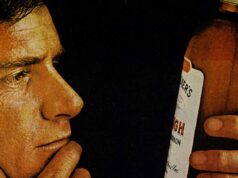During my sophomore year of college I enrolled in a course entitled Modern Sub-Saharan Africa. Despite the impressive title, the course consisted of one lecture at the University of Nairobi (same colors as Nebraska, minus the football) followed by a two-week safari through parts of Kenya and Tanzania accompanied by two professors and 20 fellow students. Not quite the Burton-Speke Expediton, but a sweet boondoggle for a 19-year-old.
On a whim, I purchased several bottles of a curious local liquor when we landed in Nairobi. Two things drew me in. First, it was dirt cheap. A 500-ml bottle was significantly, perhaps worryingly, under five dollars. This might have tipped off a wiser student, but I pressed ahead with the purchase. Besides, the label had me at hello. The flames, the color scheme, the buff silhouetted figure of a Mzaramo with hands clasped in defiance . . . perfect.
But what is Konyagi? I’ve spent the past two decades believing it to be some sort of gin, but contemporary research brought to light a list of ingredients (molasses, spices, flavorings) suggesting Konyagi to be a rum. The official Konyagi website takes no definitive position, choosing to label itself as “The Spirit of the Nation.” No doubt this is true, but I prefer the conclusion of one poetic drinker who described Konyagi as the “tears of a lion.”
Prior to my departure, the college health center provided me with an extensive list of terrifying diseases that I might contract and gave me no fewer than three shots to immunize me from one thing or another. In addition, I left campus with a daily malaria tablet and strict instructions to never skip a dosage.
It was this climate of fear that brought some of us to open the first bottle of Konyagi in Nairobi. Ostensibly we were toasting the start of our voyage, but I suspect that many of us experienced more than a little trepidation as we headed away from the relative familiarity of an urban setting to the unknown countryside. In a spirit of bonhomie, the six people in my van passed around the Konyagi to kick off the trip and entice the spirits to look favorably upon our travels.
Like other five dollar liquors, Konyagi isn’t something you want to linger in your mouth. It’s not dissimilar to the taste and feel of rubbing alcohol. A more generous review by noted booze critic Chris Carlsson describes notes of citrus, vanilla and cloves. Standing in a parking lot on the outskirts of Nairobi shortly after sunrise, I was unable to catch the subtle aromas the distiller had in mind. What I do know is taking a shot of Konyagi first thing after breakfast is a helluva way to start the day.
As the trip progressed, we witnessed breathtaking scenes of natural beauty. Although the roads were last paved during World War II, everything anyone has ever said about the beauty of the Serengeti is entirely true. Yet despite the quality of our accommodations, one by one my fellow students became ill. Nothing violent or incapacitating, but there were a number of uncomfortable people within the other vans. Oddly, no one in our van felt sick. Given that we were all traveling together–same lodgings, same meals–the only explanation was our daily shot of Konyagi.
As the days passed and the others weakened, the six of us became increasingly confident in Konyagi’s ability to protect us from whatever battles raged within our intestinal tracts. We felt watched over by the mysterious silhouetted man on the bottle. Konyagi gave us strength and killed off whatever bugs tried to attack us. Although I failed Logic in the fall semester (true story; ask my father), I knew the difficulty associated with actually drinking this liquor proved its medicinal value.
According to the official website, the origins of Konyagi stretch back more than 40 years. The Tanzanian Distillery, Limited (TDL) reached out to local distillers and invited them to bring in their products to ensure their quality and cleanliness. TDL then purified and commodified the local distillers’ product and began producing and selling it under the Konyagi name. The phrase Kinwaji safi (“drink clean”) remains on the bottle, hearkening back to the purification of traditional spirits.
Konyagi acknowledges a host of different rituals that accompany the drinking of the national spirit, but the website describes the most common in detail:
Firstly, the server will bash the bottom of the bottle with their palm several times to “release the spirit.” Only then can the bottle be opened and poured into the drinker’s glass. The bottle with the remainder of the Konyagi must then be placed flat (horizontally) and left until the drinker needs to refill their glass.
Unaware of these traditional rituals, our merry band created our own as our collective belief in the power and healing properties of Konyagi began to grow.
Each morning began the same. Before loading into our van for the day’s journey, the six of us formed a circle and began to pass the bottle. A long “good morning” pull shook off any residual sleep as the liquid heat streamed down the throat and, like the image adorning the label, a fire ignited the insides of our stomachs.
Raising your arms and clasping your hands above your head in Mzaramo-style signaled to the group that you successfully kept the Konyagi where it belonged. There were mornings when raising my hands required a Herculean effort, but I reminded myself that Konyagi was the source of my immortality.
At the end of the two weeks, the group ended the safari by spending a night in Dar es Salaam. The hotel was adequate, but I neglected to buy a bottle of water before our curfew. The night progressed and I became increasingly desperate. Panicked at the thought of spending a night in such agony (I’m a wimp, I know), I considered the impossible.
The first rule of travel in the developing world is to never drink the water. But the promise of even a little water tempted me beyond my self control. Around 2am I cracked and stuck my head under the tap of the bathroom sink. Relief washed over me and I took in as many gulps as I dared.
But I didn’t leave my health to fate alone. Immediately after wiping the water off my chin, I grabbed the bottle of Konyagi and took the largest swallow I could keep down. Raising my clasped hands overhead, I put my trust in the magic of Konyagi and headed to bed. Twenty-eight hours later I landed at Newark, suffering no ill-effects from tempting fate.
Thank you, Konyagi.










